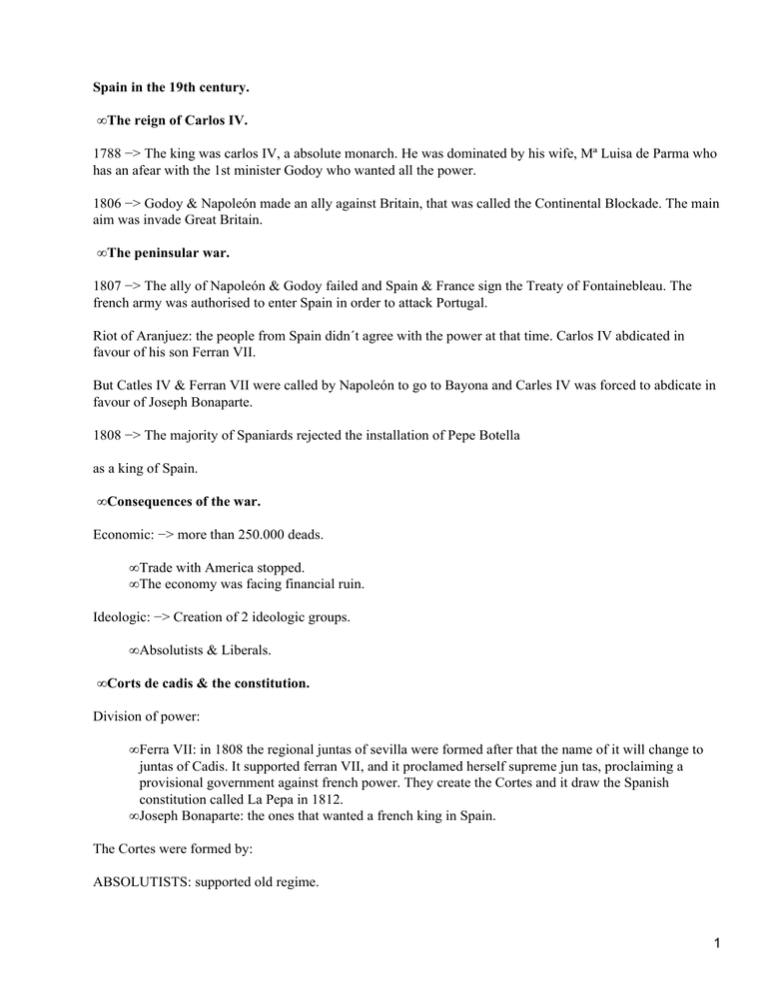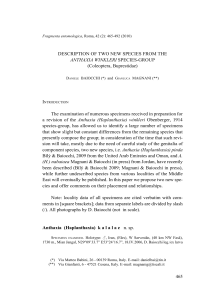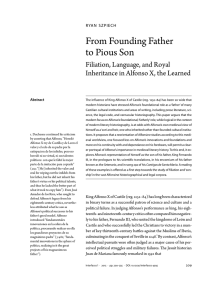Contemporary spanish history
Anuncio

Spain in the 19th century. • The reign of Carlos IV. 1788 −> The king was carlos IV, a absolute monarch. He was dominated by his wife, Mª Luisa de Parma who has an afear with the 1st minister Godoy who wanted all the power. 1806 −> Godoy & Napoleón made an ally against Britain, that was called the Continental Blockade. The main aim was invade Great Britain. • The peninsular war. 1807 −> The ally of Napoleón & Godoy failed and Spain & France sign the Treaty of Fontainebleau. The french army was authorised to enter Spain in order to attack Portugal. Riot of Aranjuez: the people from Spain didn´t agree with the power at that time. Carlos IV abdicated in favour of his son Ferran VII. But Catles IV & Ferran VII were called by Napoleón to go to Bayona and Carles IV was forced to abdicate in favour of Joseph Bonaparte. 1808 −> The majority of Spaniards rejected the installation of Pepe Botella as a king of Spain. • Consequences of the war. Economic: −> more than 250.000 deads. • Trade with America stopped. • The economy was facing financial ruin. Ideologic: −> Creation of 2 ideologic groups. • Absolutists & Liberals. • Corts de cadis & the constitution. Division of power: • Ferra VII: in 1808 the regional juntas of sevilla were formed after that the name of it will change to juntas of Cadis. It supported ferran VII, and it proclamed herself supreme jun tas, proclaiming a provisional government against french power. They create the Cortes and it draw the Spanish constitution called La Pepa in 1812. • Joseph Bonaparte: the ones that wanted a french king in Spain. The Cortes were formed by: ABSOLUTISTS: supported old regime. 1 LIBERALS: wanted to change the situation of Spain. AFRANCESADOS: in favour of Joseph Bonaparte´s government. 1814 −> Ferra VII returned to Spain and he was recognized as a king, on May 4th 1814 he reject the la pepa. 4.1 Trienni liberal. 1820 −> It was a revolution by the coronel Riego. He started a rebelion against ferra VII and forced Ferra to restore the cadis constitution. Ferra VII signed the constitution and he becames a constitutional monarch. 1823 −> He made an invasión to Spain and he asked for help to the french. Absolute monarchy restored again (1823−1833). 4.2 The last years of the reign Ferra VII was married with Mª Christina and in 1831 she was pregnad. Ferra VII died in 1833 and Ferra´s brother; Carlos de Borbón disputed Isabella´s claim to the crown arguing that a famale´s succession was forbidden by the Salic Law − womens couldn´t rule a country−. But Ferrà VII abolís it before he died. So in 1833 Isabella II was declared queen of Spain with her mother as regent. Now the powe was divided into: CARLINS: • Traditional laws. • Were located in Basque Country and Catalonia. ISABELINS: • Gave support to the liberals. • Liberals belief in a Constitution. Isabelins were divided into: Liberals moderates: Support to the crown. Narrow right of vote. Isabelins progressives: Constitutional monarchy Wanted to expand the right of vote to all the people. 1839 −> After a long fighting the Carlins were defeated. 5.The independence of the american colonies. 1898−> Cuba, philipinas Puerto Rico gave their independence. Criolles: People born in America but one of their relatives were spanish. 5.1 Causes of the independence. 2 • Spain colonies were influenced by the enlightenment and the French Rev. • They couldn´t trade with another countries. • Very high taxes. • Criolles weren´t free so they couldn´t participate in government. 7. The glorious revolution Isabella in the revolution of 1868 was overthrown, because of the political & economical crisis. The period after the revolution is known as a Democrate Sexenio. 8.2 Amadeo of Savoy. In 1870 a duke from Italy accepted the Spanish throne and was crowned Amadeus I. Amadeus abdicated in 1873 and in that year it was the First Republic in Spain. 9. Bourbon restoration. On Christmas Eve the army procalimed Isabella´s oldest living son, Alfonso XII king of Spain and the first Republic collapsed. Under Alfonso XII, the Spanish cortes drafted a constitution in 1876. And it restricted the powers of the crown. In 1885 Alfonso XII died. The son of Alfonso XII, Alfonso XII became the king of Spain in 1902 , until then Alfonso XII´s wife acted as regent. 3

